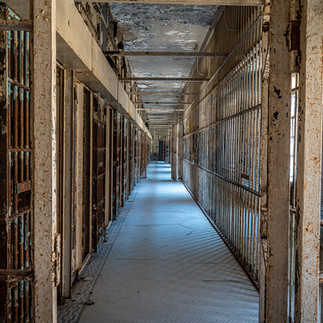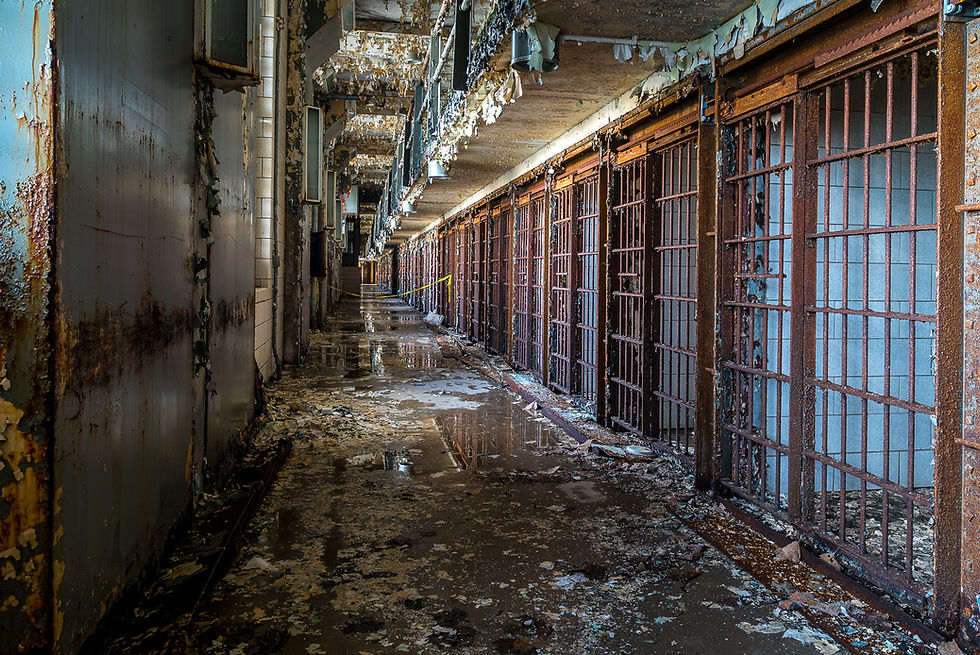The Missouri State Penitentiary
- Drew Pertl

- Dec 8, 2021
- 3 min read

Location: Jefferson City, Missouri
I recently had the opportunity to explore the Missouri State Penitentiary in Jefferson City, Missouri. Once named the “The bloodiest 47 acres in America” by Time Magazine, it was the oldest continually operating prison west of the Mississippi until it was decommissioned in 2004.
Early History (Courtesy of Wikipedia)

The Missouri State Penitentiary was designed by John Haviland and constructed in the early 1830s to serve the newly admitted (1821) state of Missouri. Jefferson City had been designated the state capital in 1822, and Governor John Miller suggested that the state's main prison be constructed there to help the city maintain its somewhat tenuous status against other towns trying to obtain the capitol for themselves.J ames Dunnica, a master stonemason who built the first Capitol building in Jefferson City in 1826, was appointed to oversee construction of the new prison, and $25,000 was allotted by the legislature for expenses. The facility opened for business in March 1836, the same month as the fall of the Alamo in Texas.
Prisoners were employed during the 1830s in making bricks; the initial prison population consisted of one guard, one warden, fifteen prisoners, and a foreman for the brick-making operation with an assistant. Eleven of the fifteen prisoners were from St. Louis, and all were incarcerated for larceny except for one, who was imprisoned for stabbing a man during a drunken brawl.
Death Row

From 1938 to 1965, thirty-nine prisoners were executed in the penitentiary's gas chamber.
Death row inmates were held in a below-ground unit and were isolated from other inmates. Death row inmates did not leave their special death row facility, and all services were brought into the unit. Each death row inmate was allowed one hour of exercise per day in a fenced area next to the death row facility. Missouri Department of Corrections said, "With restrictions on movement and limited access to programs, conditions of confinement for death row inmates mirrored those found in other states," and, "As with other states using prison facilities constructed before the turn of the [20th] century, conditions at Missouri State Penitentiary were less than favorable for both death row inmates and staff."
The Two Seated Gas Chamber

In September 1937, Governor Lloyd Crow Stark signed a bill into law calling for execution by lethal gas. Prior to this criminals in Missouri were executed by public hangings, conducted by the Sheriff in the county were the crime was committed.
The gas chamber was located at the Jefferson City Correctional Center in a small rock building set apart from the main prison. The chamber area was built in 1937 at a cost of $3,570 and consisted of two small cells on one side of the room and the chamber on the other side.

One cell housed the condemned for the last few hours before execution. The second cell was used for mixing the sulfuric acid that was used in the execution. The cell contained the crocks used to hold sulfuric acid and later placed under the perforated chair. The leather restraints that were used to hold the condemned in the chair were also stored in the second cell.
In the center of the building was the air tight chamber painted white, with two perforated steel chairs. Beneath the chairs were guides to hold the three-gallon earthen jars which contained the sulfuric acid into which the cyanide pellets were dropped when a lever was pulled by the Warden.
After the execution the lethal gas was extracted from the chamber and vented out a forty-five foot pipe through the roof of the building.
Gear for the Shoot
The camera used for this shoot was the Sony A7SII with the Sony FE Zoom 24-70mm f/2.8 GM lens. I also used a Manfrotto travel tripod to stabilize my shots. The aerial shots were taken with a DJI Mavic 2 Pro.
Technical Considerations
I knew this shoot would offer some very cool textures like peeling paint, graffiti and just some all around decay. So I opted to shoot most photos at an aperture between F8 to F11 so those small details would be captured very sharply.
In a place like this there is so much to focus on, so its a constant challenge to create a scene that's balanced and doesn't feel chaotic. This is especially true with wide shots where there really isn't a clear subject. So I often look for symmetry or patterns that help lead the eye through the busy scene.
Access to the Public
The penitentiary was decommissioned in 2004 and is now open to the public for tours. More information can be found here: www.missouripentours.com
Checkout My Additional Photos from the Trip
My full gallery of 73 photos can be viewed on Flickr here: https://flic.kr/s/aHsmWTBeG9




























Comments